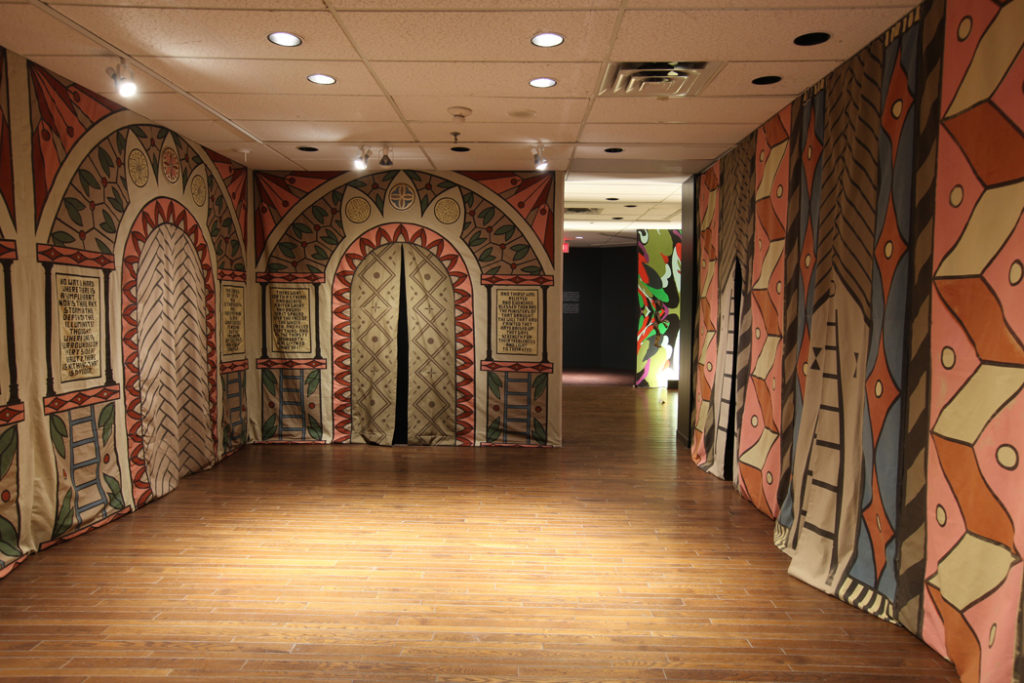1. Heather Goodchild at the Textile Museum of Canada, Toronto
In many ways, the Textile Museum of Canada is its own kind of sanctuary: nestled just off Dundas Street West in a building suspiciously unlike an art gallery, it’s a beautiful institution with ample exhibition space and a somewhat winding layout. Heather Goodchild’s installation at the Textile Museum in late-2013 to early-2014 (set alongside Jérôme Havre’s work in the two-person exhibition “Fictions and Legends,” curated by Sarah Quinton) took full advantage of this fact, guiding its visitors through a fantastical and labyrinthine space within the gallery: small rooms curtained off by silkscreened textiles featuring mythological texts, revealing tapestries or scenic sculptures inside.
From another exhibition in the gallery on the floor above, a window revealed Goodchild’s most prominent sculpture below, a stage set with large ceramic dolls in cultish garb, watched by doppelganger-like figures in drab grey dresses. Aside from this masterful transformation of an already somewhat secluded space, Goodchild’s entangling installation was an exercise in mystery and wonder—qualities I have come to hold dear as manifestations of what the potential of art, writ large, can be.
2. Terrance Houle at 7a*11d, Toronto
Terrance Houle announced this year that he is going on hiatus, so I feel particularly fortunate to have seen one of his last performances, although it also left me particularly tender. While blogging for the 7a*11d International Festival of Performance Art over the course of five days, I had the moving experience of being an embedded witness in the festival, chronicling the works I engaged in, and cataloguing my responses online almost immediately. I appreciated the exercise of this kind of rapid-fire criticism, but struggled to write about no performance more than Terrance Houle’s Friend or Foe #7.
Over the course of his performance, Houle was beaten with rolled-up, photocopied pages of academic theory by masked and gowned performers, pushed up against a chalkboard and subsequently stripped naked. A few interveners from the audience prevented the escalation of the beating, but its psychological impact persisted. He then dressed himself in a loin cloth and beaded breastplate; poured out a mound of earth; sang, smoked, cleansed and painted his body; and, finally, cut off his braids.
The fact of having witnessed and not intervened in the mounting violence continues to chill me, and it’s not a sense of delight in this performance that moves me to rank it as a “top pick” for the year. Rather, it’s a sense that this performance will be with me in ways I cannot calculate, for a long time. The performance was a demonstrative embodiment of trauma—not simply the kind inflicted upon Indigenous bodies in violent and visible ways, but the kind inflicted by complicity, by the academy and by arts institutions.
3. 99% Invisible
If the words “I just listened to a riveting podcast about fire escapes,” or “Did you know about that Trinidadian artist who invented those inflatable dancing men you see at car dealerships?” have never escaped your lips, it’s probably because you haven’t yet listened to this podcast.
99% Invisible has been an embedded part of my 2014, travelling with me on commutes, road trips and solitary walks. Each short episode about architecture and design, and their subtle governance of our interactions with the world, is completely engrossing. Near the end of 2013, 99% Invisible creator Roman Mars set up a “stretch goal” for his overfunded Kickstarter campaign to fund the podcast and created Radiotopia, a network of story-driven shows that share the qualities of artistic, exploratory, impeccably crafted radio.
Mars’s now-weekly design show anchors this indie network, and it’s resulted in a year brimming with inventive storytelling and clever reporting on visual culture.
Alison Cooley is editorial intern at Canadian Art.









